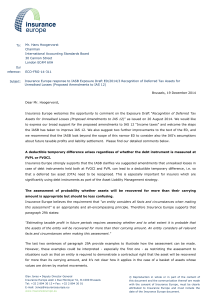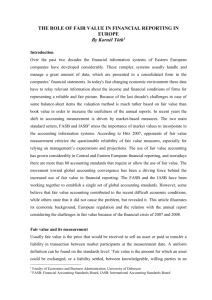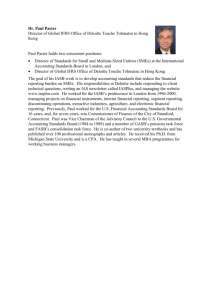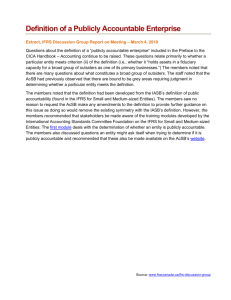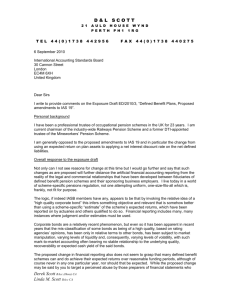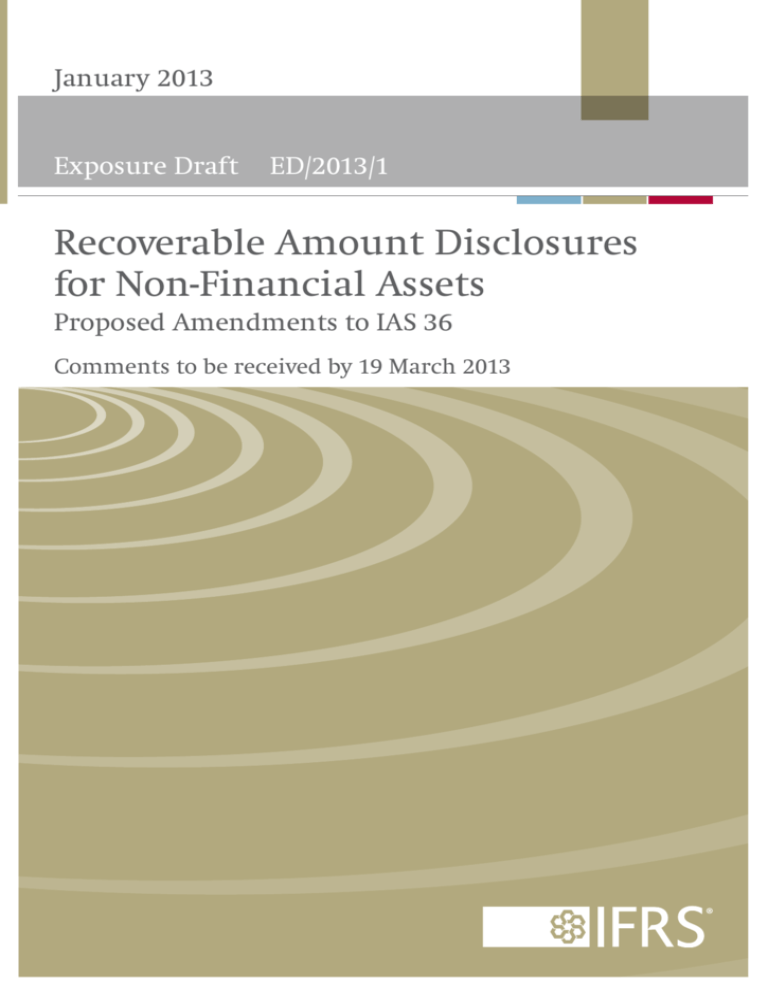
January 2013
Exposure Draft
ED/2013/1
Recoverable Amount Disclosures
for Non-Financial Assets
Proposed Amendments to IAS 36
Comments to be received by 19 March 2013
Recoverable Amount Disclosures for
Non-Financial Assets
(Proposed Amendments to IAS 36)
Comments to be received by 19 March 2013
Exposure Draft ED/2013/1 Recoverable Amount Disclosures for Non-Financial Assets (Proposed
Amendments to IAS 36) is published by the International Accounting Standards Board (IASB)
for comment only. The proposals may be modified in the light of the comments received
before being issued in final form as amendments to Standards. Comments on the Exposure
Draft, the Basis for Conclusions and the Illustrative Examples should be submitted in
writing so as to be received by 19 March 2013. Respondents are asked to send their
comments electronically to the IASB website (www.ifrs.org), using the ‘Comment on a
proposal’ page.
All responses will be put on the public record unless the respondent requests
confidentiality. However, such requests will not normally be granted unless supported by
good reason, such as commercial confidence.
The IASB, the IFRS Foundation, the authors and the publishers do not accept responsibility
for loss caused to any person who acts or refrains from acting in reliance on the material in
this publication, whether such loss is caused by negligence or otherwise.
Copyright © 2013 IFRS Foundation®
ISBN: 978-1-907877-80-3
International Financial Reporting Standards (including International Accounting Standards
and SIC and IFRIC Interpretations), Exposure Drafts, and other IASB publications are
copyright of the IFRS Foundation. The approved text of International Financial Reporting
Standards and other IASB publications is that published by the IASB in the English
language. Copies may be obtained from the IFRS Foundation. Please address publications
and copyright matters to:
IFRS Foundation Publications Department,
1st Floor, 30 Cannon Street, London EC4M 6XH, United Kingdom.
Tel: +44 (0)20 7332 2730 Fax: +44 (0)20 7332 2749
Email: publications@ifrs.org Web: www.ifrs.org
All rights reserved. Copies of the draft amendments and the accompanying documents may
be made for the purpose of preparing comments to be submitted to the IASB, provided such
copies are for personal or intra-organisational use only and are not sold or disseminated
and provided each copy acknowledges the IFRS Foundation’s copyright and sets out the
IASB’s address in full. Otherwise, no part of this publication may be translated, reprinted or
reproduced or utilised in any form either in whole or in part or by any electronic,
mechanical or other means, now known or hereafter invented, including photocopying and
recording, or in any information storage and retrieval system, without prior permission in
writing from the IFRS Foundation.
The IFRS Foundation logo/the IASB logo/‘Hexagon Device’, ‘IFRS Foundation’, ‘eIFRS’, ‘IAS’,
‘IASB’, ‘IASC Foundation’, ‘IASCF’, ‘IFRS for SMEs’, ‘IASs’, ‘IFRIC’, ‘IFRS’, ‘IFRSs’, ‘International
Accounting Standards’, ‘International Financial Reporting Standards’ and ‘SIC’ are Trade
Marks of the IFRS Foundation.
RECOVERABLE AMOUNT DISCLOSURES
FOR
NON-FINANCIAL ASSETS
CONTENTS
from page
INTRODUCTION
4
INVITATION TO COMMENT
5
[DRAFT] AMENDMENTS TO IAS 36 IMPAIRMENT OF ASSETS
7
APPROVAL OF THE EXPOSURE DRAFT BY THE BOARD
9
BASIS FOR CONCLUSIONS
10
[DRAFT] AMENDMENTS TO THE ILLUSTRATIVE EXAMPLES OF IAS 36
IMPAIRMENT OF ASSETS
12
3
姝 IFRS Foundation
EXPOSURE DRAFT—JANUARY 2013
Introduction
The International Accounting Standards Board (IASB) has published this Exposure Draft to
set out proposed modifications to the disclosures in IAS 36 Impairment of Assets for the
measurement of the recoverable amount of impaired assets. Those disclosure requirements
were introduced by IFRS 13 Fair Value Measurement, issued in May 2011.
When developing IFRS 13, the IASB decided to amend IAS 36 to require the disclosure of
information about the recoverable amount of impaired assets, particularly if that amount is
based on fair value less costs of disposal. However, it has come to the IASB’s attention that
some of the amendments made to IAS 36 have resulted in the requirement being more
broadly applicable than the IASB intended. In particular, the IASB had originally intended
that the amendment would require an entity to disclose the recoverable amount of an asset
(including goodwill) for which an impairment loss was recognised or reversed during the
reporting period. However, instead, an entity is now required to disclose the recoverable
amount of each cash-generating unit for which the carrying amount of goodwill or
intangible assets with indefinite useful lives allocated to that unit is significant when
compared to the entity’s total carrying amount of goodwill or intangible assets with
indefinite useful lives. This Exposure Draft proposes amendments to IAS 36 that would
better represent the IASB’s intention for those disclosure requirements.
In addition, one of the amendments proposed in this Exposure Draft overlaps with an
amendment to IAS 36 that had been proposed by the Exposure Draft Annual Improvements to
IFRSs 2010–2012 Cycle published in May 2012. That Exposure Draft proposed an amendment
that would require an entity to disclose the discount rate that was used in a present value
technique in order to determine the recoverable amount of an impaired asset, regardless of
whether that recoverable amount was based on fair value less costs of disposal or value in
use. That proposal has been incorporated into this Exposure Draft and we are not
requesting comments in response to this topic.
姝 IFRS Foundation
4
RECOVERABLE AMOUNT DISCLOSURES
FOR
NON-FINANCIAL ASSETS
Invitation to comment
The IASB invites comments on the proposals in this Exposure Draft, particularly on the
questions set out below. Comments are most helpful if they:
(a)
comment on the questions as stated;
(b)
indicate the specific paragraph(s) to which they relate;
(c)
contain a clear rationale; and
(d)
describe any alternative that the IASB should consider, if applicable.
The IASB is not requesting comments on matters in IAS 36 that are not addressed in this
Exposure Draft. Moreover, the IASB is not requesting comments on the proposed
amendment to require an entity to disclose the discount rate used in a present value
technique, because this topic was already subject to public comments during the Annual
Improvements to IFRSs 2010–2012 Cycle. The IASB will consider the comments received on the
Annual Improvements Exposure Draft as it finalises the proposals in this Exposure Draft.
The IASB will consider all comments received in writing by 19 March 2013. In considering
the comments, the IASB will base its conclusions on the merits of the arguments for and
against each alternative, not on the number of responses supporting each one.
Questions for respondents
Question 1—Disclosures of recoverable amount
The IASB proposes to remove the requirement in paragraph 134(c) to disclose the
recoverable amount of each cash-generating unit (group of units) for which the carrying
amount of goodwill or intangible assets with indefinite useful lives allocated to that
unit (group of units) is significant when compared to the entity’s total carrying amount
of goodwill or intangible assets with indefinite useful lives. In addition, the IASB
proposes to amend paragraph 130 to require an entity to disclose the recoverable
amount of an individual asset (including goodwill) or a cash-generating unit for which
the entity has recognised or reversed an impairment loss during the reporting period.
Do you agree with the proposed amendments? If not, why and what alternative do you
propose?
5
姝 IFRS Foundation
EXPOSURE DRAFT—JANUARY 2013
Question 2—Disclosures of the measurement of fair value less costs of disposal
The IASB also proposes to include in paragraph 130 the requirement to disclose the
following information about the fair value less costs of disposal of an individual asset
(including goodwill) or a cash-generating unit for which the entity has recognised or
reversed an impairment loss during the reporting period:
(a)
the valuation technique(s) used to measure fair value less costs of disposal and, if
there has been a change in the valuation technique, that change and the
reason(s) for making it;
(b)
the level of the fair value hierarchy within which the fair value measurement of
the asset is categorised in its entirety (without taking into account whether the
‘costs of disposal’ are observable); and
(c)
for fair value measurements that are categorised within Levels 2 and 3 of the fair
value hierarchy, the key assumptions used in the measurement.
Do you agree with the proposed amendments? If not, why and what alternative do you
propose?
Question 3—Transition provisions
The IASB proposes that the amendments should be applied retrospectively for annual
periods beginning on or after 1 January 2014. The IASB also proposes to permit earlier
application, but will not require an entity to apply those amendments in periods
(including comparative periods) in which the entity does not also apply IFRS 13.
Do you agree with the proposed transition method and effective date? If not, why and
what alternative do you propose?
Question 4—Other comments
Do you have any other comments on the proposals?
姝 IFRS Foundation
6
RECOVERABLE AMOUNT DISCLOSURES
FOR
NON-FINANCIAL ASSETS
[Draft] Amendments to IAS 36 Impairment of Assets
Paragraphs 130 and 134 are amended and paragraph 140J is added. New text is
underlined and deleted text is struck through.
Disclosure
130
An entity shall disclose the following for each impairment loss recognised or
reversed during the period for an individual asset, including goodwill, or a
cash-generating unit:
...
(e)
the recoverable amount of the impaired asset and whether the
recoverable amount of the asset (cash-generating unit) is its fair value
less costs of disposal or its value in use.
(f)
if recoverable amount is fair value less costs of disposal, the basis used to
measure fair value less costs of disposal (such as whether fair value was
measured by reference to a quoted price in an active market for an
identical asset). an entity shall disclose the following information:
(i)
a description of the valuation technique(s) used to measure fair
value less costs of disposal. If there has been a change in
valuation technique, an entity shall disclose that change and the
reason(s) for making it;
(ii)
the level of the fair value hierarchy (see IFRS 13) within which the
fair value measurement of the asset is categorised in its entirety
(without taking into account whether the ‘costs of disposal’ are
observable); and
(iii)
for fair value measurements categorised within Levels 2 and 3 of
the fair value hierarchy, each key assumption on which
management has based its determination of fair value less costs
of disposal. Key assumptions are those to which the asset’s
(cash-generating unit’s) recoverable amount is most sensitive and
include the discount rate(s) used in the measurement if fair value
less costs of disposal is measured using a present value technique.
An entity shall also disclose the discount rate used in the
previous measurement (if any).
An entity is not required to provide the disclosures required by IFRS 13.
134
An entity shall disclose the information required by (a)–(f) for each
cash-generating unit (group of units) for which the carrying amount of goodwill
or intangible assets with indefinite useful lives allocated to that unit (group of
units) is significant in comparison with the entity’s total carrying amount of
goodwill or intangible assets with indefinite useful lives:
...
7
姝 IFRS Foundation
EXPOSURE DRAFT—JANUARY 2013
(c)
the recoverable amount of the unit (or group of units) and the basis on
which the unit’s (group of units’) recoverable amount has been
determined (ie value in use or fair value less costs of disposal).
Transition provisions and effective date
...
140J
In [date] 2013 paragraphs 130 and 134 were amended. An entity shall apply
those amendments retrospectively for annual periods beginning on or after
1 January 2014. Earlier application is permitted. An entity shall not apply those
amendments in periods (including comparative periods) in which it does not
also apply IFRS 13.
姝 IFRS Foundation
8
RECOVERABLE AMOUNT DISCLOSURES
FOR
NON-FINANCIAL ASSETS
Approval by the Board of Recoverable Amount Disclosures
for Non-Financial Assets (Proposed Amendments to IAS 36)
published in January 2013
The Exposure Draft Recoverable Amount Disclosures for Non-Financial Assets was approved for
publication by fourteen members of the International Accounting Standards Board.
Ms Tokar abstained because she had only recently been appointed to the Board.
Hans Hoogervorst
Chairman
Ian Mackintosh
Vice-Chairman
Stephen Cooper
Philippe Danjou
Martin Edelmann
Jan Engström
Patrick Finnegan
Amaro Luiz de Oliveira Gomes
Prabhakar Kalavacherla
Patricia McConnell
Takatsugu Ochi
Darrel Scott
Chungwoo Suh
Mary Tokar
Wei-Guo Zhang
9
姝 IFRS Foundation
EXPOSURE DRAFT—JANUARY 2013
Basis for Conclusions on the Exposure Draft Recoverable
Amount Disclosures for Non-Financial Assets (Proposed
Amendments to IAS 36)
This Basis for Conclusions accompanies, but is not part of, the proposed amendments.
Changes as a result of IFRS 13 Fair Value Measurement
Recoverable Amount Disclosures for Non-Financial
Assets
BC1
As a consequence of issuing IFRS 13 Fair Value Measurement, the IASB modified
some of the disclosure requirements in IAS 36 Impairment of Assets for measuring
the recoverable amount of impaired assets. Those amendments resulted from
the IASB’s decision to require additional disclosures about the measurement of
the recoverable amount of impaired assets, particularly when the recoverable
amount was based on fair value less costs of disposal. The IASB intended to
require information about how such fair values were measured, but also wanted
to retain a balance between the disclosures about fair value less costs of disposal
and the disclosures about value in use.
BC2
After issuing IFRS 13, the IASB was made aware that one of the amendments that
Standard made to IAS 36 resulted in the disclosure requirements being more
broadly applicable than the IASB had intended. That amendment required the
disclosure of the recoverable amount of any cash-generating units with a
significant carrying amount of goodwill or intangible assets with indefinite
useful lives. However, the IASB’s intention was to require only the disclosure of
the recoverable amount of assets, including goodwill, for which there was an
impairment loss recognised or reversed during the reporting period.
BC3
Consequently, the IASB proposes to amend paragraphs 130 and 134 to make
clear the IASB’s intention that the requirement stipulates the disclosure of the
recoverable amount of impaired assets, including goodwill, only. The IASB also
proposes to amend paragraph 130 to require information about the fair value
measurement when the recoverable amount is based on fair value less costs of
disposal, consistently with the disclosure requirements for impaired assets in
US GAAP. The IASB considered whether there should be consistency between the
wording of the disclosure requirements in IAS 36 (which uses the term
‘assumptions’) with the measurement requirements in IFRS 13 (which uses the
term ‘inputs’). The IASB concluded that it is unlikely that those terms could
have different meanings because IFRS 13 defines ‘inputs’ as “the assumptions
that market participants would use when pricing the asset or liability…”
[emphasis added]. In addition, the IASB wanted to make it clear that the
proposed amendment does not change the meaning of the information that is
required to be disclosed in accordance with IAS 36. Furthermore, the IASB
proposes to remove the term ‘material’ from paragraph 130. The IASB
concluded that it is unnecessary to state explicitly that the disclosure relates to a
material impairment loss recognised or reversed during the period because all
IFRSs are governed by the concept of materiality as described in IAS 1 Presentation
姝 IFRS Foundation
10
RECOVERABLE AMOUNT DISCLOSURES
FOR
NON-FINANCIAL ASSETS
of Financial Statements (see in particular paragraph 31 of IAS 1) and in IAS 8
Accounting Policies, Changes in Accounting Estimates and Errors.
BC4
The proposed amendments overlap with an amendment to paragraph 130(f) of
IAS 36 that was proposed in the Exposure Draft Annual Improvements to IFRSs
2010–2012 Cycle (ED/2012/1) published in May 2012. The proposal in that
Exposure Draft was intended to harmonise the disclosure requirements for value
in use and fair value less costs of disposal by adding to paragraph 130(f) the
requirement to disclose the discount rate(s) that are used in the current and
previous measurements, if any, when the fair value less costs of disposal is
measured using a present value technique. Sixty-four respondents commented
on that proposal. Nearly all of those respondents supported that proposed
amendment.
BC5
When discussing whether to add paragraph 130(f)(iii) to IAS 36, the IASB
considered whether the discount rate that is used in a present value technique
would be a ‘key assumption’ as described in that proposed new paragraph.
Although the IASB concluded that it would be unlikely that an entity could
consider the discount rate not to be a key assumption, it wanted to ensure that
an entity would always disclose the discount rate if fair value less costs of
disposal is based on a present value technique. Requiring that disclosure would
also align the disclosures about fair value less costs of disposal with those about
value in use, which require disclosure of the discount rate used. Consequently,
the IASB proposes to require an entity to explicitly disclose the discount rate, in
addition to the other key assumptions used in the measurement of fair value less
costs of disposal. As a result of that decision, the IASB decided not to proceed
with the amendment to IAS 36 as proposed in ED/2012/1, but to instead
incorporate it into the proposed amendments in this Exposure Draft.
BC6
The IASB proposes to require an entity to apply the amendments retrospectively.
The IASB also proposes to permit earlier application of the amendments.
However, if an entity applies the amendments early, it is not required to provide
comparative information for the prior period if it is not also providing
comparative information in accordance with IFRS 13. In the IASB’s view, the
result of applying the proposed amendments should be the same as if the entity
applied them when it initially applied IFRS 13.
11
姝 IFRS Foundation
EXPOSURE DRAFT—JANUARY 2013
[Draft] Amendments to the Illustrative Examples of IAS 36
Impairment of Assets
Example 10 is added.
Example 10 Disclosures about fair value less costs of disposal
The purpose of this example is to illustrate the disclosures required by paragraphs 130(b) and 130(f)(ii) of
IAS 36.
IE90
If the recoverable amount of an individual asset, including goodwill, or a
cash-generating unit for which an impairment loss is recognised, or reversed
during the reporting period, is fair value less costs of disposal, IAS 36 requires an
entity to disclose the level of the fair value hierarchy within which the fair value
measurement of the asset is categorised in its entirety (without taking into
account whether the ‘costs of disposal’ are observable). An entity might disclose
the following information to comply with paragraphs 130(b) (which requires
disclosure of the amount of an impairment loss or reversal) and 130(f)(ii) of the
IAS 36:
Recoverable amount (based on fair value less
costs of disposal) at the end of the reporting
Impairment recognised during
period using
the period
(CU in millions)
Description
31/12/X9
Quoted
Significant
Significant
prices in
other
unobservable
active
observable
inputs
markets for
inputs
(Level 3)
identical
(Level 2)
(Losses)
Reversals
assets
(Level 1)
(a)
Land
75
75
(25)
0
Goodwill(b)
30
30
(35)
n/a
(a) In accordance with IAS 36, land with a carrying amount of CU100 million has been written down
to its fair value less costs of disposal of CU75 million, resulting in an impairment loss of
CU25 million, which was included in other expenses in profit or loss for the period.
(b) In accordance with IAS 36, goodwill with a carrying amount of CU65 million has been written
down to its implied fair value less costs of disposal of CU30 million, resulting in an impairment
loss of CU35 million, which was included in other expenses in profit or loss for the period.
姝 IFRS Foundation
12


